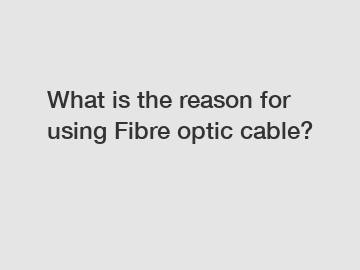Jan. 30, 2024
Electrical Equipment
What is the reason for using Fibre optic cable? Fibre optic cable is utilized due to its various advantages and capabilities over traditional copper cables.
Fibre optic cable, also known as optical fiber cable, is a flexible, transparent strand made of pure glass or plastic, which allows for the transmission of data, information, and signals at incredibly fast speeds. It is widely used in telecommunications, internet connections, and networking systems.
The primary reason for using fibre optic cable is its ability to transmit data over long distances without signal loss. Unlike copper cables, which are prone to electromagnetic interference and signal degradation, fibre optic cables use light signals to transmit data. This technology facilitates high-speed data transfer, offers superior clarity and reliability, and allows for a greater bandwidth capacity.

The use of fibre optic cable has revolutionized the telecommunications industry. The significant increase in data consumption and the demand for fast and reliable internet connections in recent years necessitated the development of advanced infrastructure. Fibre optic cables have become the backbone of this infrastructure due to their ability to transmit large amounts of data at rapid speeds.
The advantages of fibre optic cables can be further explained through their physical properties. These cables are made of glass or plastic, which gives them the ability to transmit light signals over long distances. The inner core, called the 'core,' is surrounded by a layer called the 'cladding.' The cladding has a lower refractive index than the core, which ensures that the light signals remain within the cable and do not escape. This property, known as total internal reflection, contributes to the minimal loss of signal strength.
Furthermore, fibre optic cables are immune to electromagnetic interference (EMI) and radio frequency interference (RFI). This immunity allows data to be transmitted with minimal distortion, resulting in a clearer and more reliable signal. Additionally, fibre optic cables are thinner and lighter than copper cables, making them easier to install and maintain.
The significance of fibre optic cables extends beyond their technical capabilities. They have played a crucial role in the advancement of technology, enabling the growth of various industries and applications. High-speed internet connections are now available in remote areas, allowing for improved communication, online education, telemedicine, and e-commerce. The increased bandwidth capacity provided by fibre optic cables has also fostered the development of cloud computing, video streaming, and virtual reality technologies.
In conclusion, fibre optic cable is used due to its superior performance and numerous advantages over traditional copper cables. Its ability to transmit data over long distances without signal loss, immunity to electromagnetic interference, and high bandwidth capacity make it an ideal choice for telecommunication and networking systems. The inclusion of fibre optic cables has transformed the way we communicate, work, and access information, enabling the growth and development of various industries and applications.
For more information, please visit twisted pair speaker cable, Indoor 10 Gigabit Multi-Mode Multi-Core Optical Cables, China Usb Cable Supplier.
Previous: What is a plunger limit switch?
Next: Which Waterproof 5 Pin Connector is Best for Outdoor Adventures?
If you are interested in sending in a Guest Blogger Submission,welcome to write for us!
All Comments ( 0 )